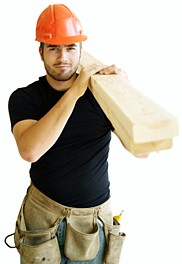How to Paint Kitchen Cabinets
Painting kitchen cabinets is an easy and fairly inexpensive way to change the look of your kitchen. In order to paint your kitchen cabinets, you will need paint remover, a mild detergent, primer, paint, a paint pan, paintbrushes, a scraper, sandpaper, paint rollers, and a wood-patching compound.
Choosing a Paint
When choosing paint for your cabinets, make sure that you purchase paint labeled "heavy-duty," since cabinets undergo a lot of wear and handling. Prepare to use at least two coats of paint, and consider semi-gloss or high gloss enamel instead of wall paint, as it is more durable. If your cabinets are currently painted with oil-based paint, you will need to use the same type. Otherwise, it is generally easier to use latex, or water-based paint, since it is much easier to clean up.
Preparing the Cabinets
Prep a work area where you will have adequate room (and ventilation) to spread out the cabinet doors and drawers for painting. If you plan to do this outdoors, check the paint can for suggested minimum temperature. Unless you can set up in a garage or another part of the house, if it's winter, you may have to wait for a warm day to paint your cabinets. Set up newspaper or drop clothes to protect the workspace.
 Before you begin, you will need to empty all kitchen cabinets. With a screwdriver, remove all doors, removable shelves, drawers, and knobs or other hardware. You may want to devise a system to keep track of which door/drawer goes where to speed reinstallation when you're done. If you are going to use the same hardware, set it aside to clean and replace. At this point, the inside of your cabinets should be cleaned with a damp sponge.
Before you begin, you will need to empty all kitchen cabinets. With a screwdriver, remove all doors, removable shelves, drawers, and knobs or other hardware. You may want to devise a system to keep track of which door/drawer goes where to speed reinstallation when you're done. If you are going to use the same hardware, set it aside to clean and replace. At this point, the inside of your cabinets should be cleaned with a damp sponge.
Next, clean the cabinet doors with a damp sponge and mild detergent. Make sure all traces of detergent are off the doors, and dry them. Using the scraper, scrap off any loose paint, and check for dents or severe scratches. If you find any, fill them with the wood-patching compound. Let the compound dry.
After the doors and any wood-patching compound applied are completely dry, sand all surfaces of the cabinets. Make sure that the wood-patching compound is sanded flush with the wood. Carefully wipe away all the sawdust left from sanding and prime any bare wood or wood-patching compound with paint primer.
Painting the Cabinets
Painting the kitchen cabinets will be much easier — and less messy — if it is done in a certain order. Begin with the interior walls of the cabinet. First the back walls of the interior cabinet should be painted, and then the inside top or "ceiling" of the cabinet. Next, the interior sides of the cabinet should be painted, and finally the interior bottom of the cabinets. Next, paint any shelves that are fixed in the cabinets.
The large outer surfaces of the kitchen cabinets can be painted using a paint roller. Make sure you work from the top down for the best coverage. After this, paint both sides of the cabinet doors which have been removed, beginning with the inner surface. Finally, paint the fronts of all drawers. When the paint is completely dry, check all painted surfaces to see if any of them need two coats of paint. At least two coats of paint are recommended for better coverage and durability. Be sure to let each coat completely dry before applying the next coat.
It is best to let the drawers and cabinet doors dry for at least two days to make sure they are thoroughly dry. Drying time will depend on what type of paint you use, temperature and humidity — refer to the paint instructions for guidelines. After several days, re-install the hardware and drawers, and rehang the doors. Your kitchen will appear dramatically different.
Written by Bronwyn Harris
